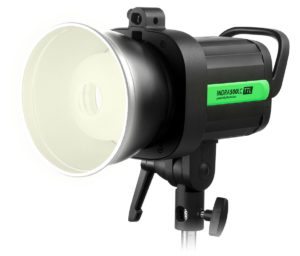
Phottix hands-on at Photokina 2018 Phottix has launched a new operating system for its portable flash systems that it says automatically switches between different manufacturer’s TTL systems as it detects their presence from an on-camera flash unit or on-camera transmitter.
The Odin Z operating system also offers an auto metering feature that suggests a manual power setting for the photographer to dial in, and now shows power settings in real time on the slave flash display as it is changed via the commander unit.
Along with the new OS the company has launched two new hotshoe flash units and a Lite version of its Odin transmitter.
We got some time with Phottix CEO Steve Peer who showed us around the new kit. Prices of all the released items have yet to be set. For more information see the Phottix website.
The first new flash (above) is called Juno TTL and seems pretty close to the Mitros + unit the company currently offers. It has a guide number of 60m at the 200mm zoom setting, while the Mitros + has a GN of 58m and a maximum zoom of 105mm. It is just as nicely made as the Mitros + and it about the same size.
Phottix hands-on at Photokina 2018
The new Juno TTL is compatible with the Elincrom Skyport system, as well as the collection of other Phottix communication protocols for older or less sophisticated units. The flash can command or be commanded, by the Odin studio flashes, and triggered by non-TTL Ares products by radio. Optical systems can also be controlled or used to control the Juno TTL.
Phottix hands-on at Photokina 2018
The Odin Z system, and the Juno TTL flash, will offer TTL control for Canon, Nikon, Pentax and Sony camera systems. Peer tells us he is ‘thinking about’ Panasonic/Olympus and Fujifilm systems, but that demand is much lower for users of those brands. The Odin Z system still works for the other camera brands, just not in TTL mode.
Phottix hands-on at Photokina 2018
As you might expect, the head swivels about 180 degrees in each direction and can tilt upwards by 90 degrees, and the zoom head can be controlled manually or automatically over a range of 20mm to 200mm. As you can see, the Juno TTL runs on four AA cells.
Phottix hands-on at Photokina 2018
The Odin Lite transmitter is designed to control a network of flash units and studio heads in manual mode, and doesn’t support TTL flash exposure. Steve Peers says that 70% of Phottix customers want to shoot with their flashes in manual mode the majority of the time, so this unit is for those for who TTL is inappropriate.
As it isn’t TTL it will work with any camera system – the central pin on the foot has been positioned so that it will still connect with the camera’s hotshoe system even when the trigger connector isn’t absolutely in the middle of the hotshoe. The Odin Lite offers 4 groups and 32 channels. Channels 5-32 use the Phottix Digital ID system for an extra secure connection.
Phottix hands-on at Photokina 2018
The Juno Li60 is another new flash unit that is almost the same as the standard Juno, but it only operates in manual mode and is powered by a lithium battery instead of AAs. It has the same 60m guide number as the Juno, and as it doesn’t operation with TTL it can be used with any camera system. This is a very pre-production unit that doesn’t have the name printed on it yet.
Phottix hands-on at Photokina 2018
The Juno Li60 takes a massive lithium ion battery instead of the usual AA batteries of the Mitros + models. The pack is rated 3200mAh, which compares well to the 2000mAh of the VB18 in the Godox V860 II that I used to shoot the pictures. Peer couldn’t say how many full power bursts we should expect per charge, but it I’d expect that sort of battery to last well.
Phottix hands-on at Photokina 2018
The rear of the Juno Li60 looks just the same as that of the regular Juno and the TTL version, but the display is simpler as it only shows manual flash settings. It doesn't have the new flash exposure meter mode.
Phottix hands-on at Photokina 2018
Also on the stand were the company’s new Nuada LED panels. The R (left and right) and R3 (centre). The three have a heavily diffused surface and produce really very soft and attractive light. The R3 measures 428mm across, and is only 33mm thick/thin.
Phottix hands-on at Photokina 2018
The R3 runs on V-lock batteries, but comes with an adapter for NP batteries. And of course, it can be powered from the mains via the included AC adapter. The light puts out 1100Lux at 1m and allows its temperature to be varied between 3200 and 5600K.
Phottix hands-on at Photokina 2018
A new panel is the Nuada S3 from the square/rectangle series which outputs 850 Lux at 1m. The panel measures 2376x266x25mm and again produces a really soft light - as modeled here by CEO Steve Peer.
Phottix hands-on at Photokina 2018
The panel is also powered by NP batteries or via the AC adapter, but doesn’t take V-Lock batteries. As with the R3, the S3 has a variable temperature of between 3200-5600K, and a CRI of >95.
. dpreview.com2018-9-30 15:00

